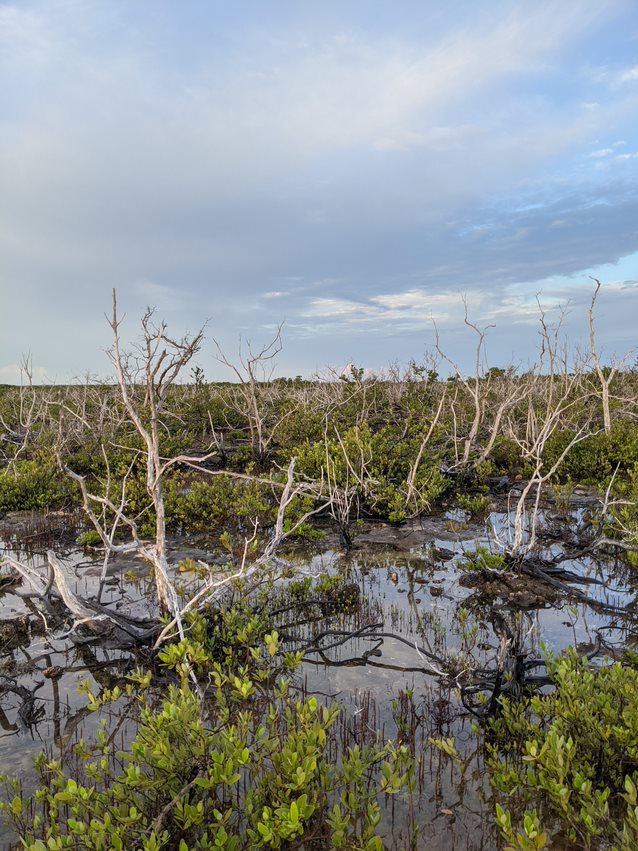-
A newly published study in the journal Biodiversity and Conservation describes the response to sea level rise by an endangered species only found in the Florida Keys.
-
The silver rice rat moved to higher elevations at a greater rate than the observed rise in sea level, during two separate data collections in 2004 and 2021.
-
The researchers say that the study highlights the vulnerability of coastal species to sea level rise.
 The silver rice rat, an endangered species endemic to the Florida Keys, makes its home as close to the shoreline as possible for easy access to its low-tide marine species diet.
The silver rice rat, an endangered species endemic to the Florida Keys, makes its home as close to the shoreline as possible for easy access to its low-tide marine species diet.
It is this proximity to the water that prompted a team of scientists at the University of Florida to examine the rats’ movement in correlation with historical tidal data over 17 years. The sea level rose 0.142 meters between 2004 and 2021, and the researchers also found that the rats moved to higher ground. In fact, the rats shifted at a slightly greater rate than the observed rise in sea level.
“We expected them to shift upslope, but it was surprising that the elevational range shift was so clear and more than we expected from the rise in sea level,” said Paul Taillie, the lead author, who completed the study as a postdoctoral researcher in the lab of Robert McCleery, UF/IFAS professor of wildlife ecology. “Part of this could be because sea level rise changes year to year. But there was also Hurricane Irma in 2017, which facilitated an upward push of coastal species.”

Taillie, now an assistant professor of geography in the College of Arts and Sciences at the University of North Carolina at Chapel Hill, explained that he and McCleery began working on rice rats in 2019 after the U.S. Fish and Wildlife Service (USFWS) became concerned about the status of the endangered species following Irma.
“We still don’t know where the rats go during hurricanes, but we do know that they were around after Hurricane Irma,” Taillie said. “They might climb up trees and wait for the storm surge to subside, and then come back down and rebuild their nests. They can swim, too.”
To understand how the rice rat responded to changes in sea level rise, Taillie and McCleery partnered with the USFWS, which had previously collected data on the movements of rice rats on one island in the Keys.
In that study, the rats were trapped and fitted with telemetry collars, which allowed researchers to track their movements. In revisiting this data, Taillie and McCleery used a similar approach in 2021 to track rats on three of the islands. They then compared each data set’s elevation with the sea level at the time the information was collected.
“Telemetry is very tricky. You first have to catch the animals and get the collars on them, and even when you do that, you may get some malfunction,” Taillie said. “They may fall off, or the rats like to chew off the antenna, and they will eventually gnaw off the collar.”
Fortunately for the researchers, silver rice rats keep to a fairly predictable routine. They nest under bushes or shrubs at very low elevation, taking advantage of low tide to reach their below-sea-level prey, which include small crabs and snails.
“The rice rat will come out of the nest when the tide is out, an elevational migration of just a few centimeters,” Taillie said. “Originally, we thought that, because this is a coastal species occurring at the very lowest elevations, we might see them benefit from sea level rise, but they’re very restricted in terms of their diet and the environment, living in a very narrow band of the coastal zone. They’re sensitive to these changes.”
McCleery added that the study showed that while animals can adapt to sea level rise, there are limits to their resilience.
“Projecting trends into the future, we found dramatic declines in the amount of habitat that would be available for rats in the coming decades if no actions are taken,” McCleery said. “This highlights the vulnerability of Florida’s unique coastal wildlife to sea level rise in the years to come.”
The study, “Sea level rise adaptation pushes an insular endemic rodent closer to extinction” is now published in the journal Biodiversity and Conservation: doi.org/10.1007/s10531-023-02669-w.
By Kirsten Romaguera Rabin, University of Florida, Institute of Food and Agricultural Sciences
